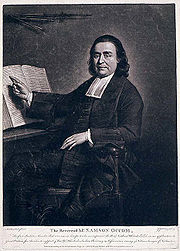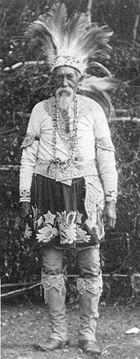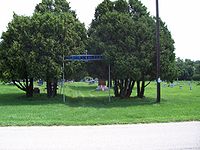
Brothertown Indians
Encyclopedia


Pequot
Pequot people are a tribe of Native Americans who, in the 17th century, inhabited much of what is now Connecticut. They were of the Algonquian language family. The Pequot War and Mystic massacre reduced the Pequot's sociopolitical influence in southern New England...
and Mohegan
Mohegan
The Mohegan tribe is an Algonquian-speaking tribe that lives in the eastern upper Thames River valley of Connecticut. Mohegan translates to "People of the Wolf". At the time of European contact, the Mohegan and Pequot were one people, historically living in the lower Connecticut region...
(Algonquian-speaking
Algonquian languages
The Algonquian languages also Algonkian) are a subfamily of Native American languages which includes most of the languages in the Algic language family. The name of the Algonquian language family is distinguished from the orthographically similar Algonquin dialect of the Ojibwe language, which is a...
) tribes in southern New England
New England
New England is a region in the northeastern corner of the United States consisting of the six states of Maine, New Hampshire, Vermont, Massachusetts, Rhode Island, and Connecticut...
. The Brothertown Indians were the first tribe of Native Americans
Native Americans in the United States
Native Americans in the United States are the indigenous peoples in North America within the boundaries of the present-day continental United States, parts of Alaska, and the island state of Hawaii. They are composed of numerous, distinct tribes, states, and ethnic groups, many of which survive as...
in the United States
United States
The United States of America is a federal constitutional republic comprising fifty states and a federal district...
to become United States citizens and relinquish their tribal sovereignty
Tribal sovereignty
Tribal sovereignty in the United States refers to the inherent authority of indigenous tribes to govern themselves within the borders of the United States of America. The federal government recognizes tribal nations as "domestic dependent nations" and has established a number of laws attempting to...
.
Tribe forms in New England
The Brothertown Indian Nation (Eeyamquittoowauconnuck) was formed by Samson OccomSamson Occom
The Reverend Samson Occom was a Native American Presbyterian clergyman and a member of the Mohegan nation near New London, Connecticut...
(famed Presbyterian minister, member of the Mohegan tribe of Connecticut, and fundraiser for Dartmouth College
Dartmouth College
Dartmouth College is a private, Ivy League university in Hanover, New Hampshire, United States. The institution comprises a liberal arts college, Dartmouth Medical School, Thayer School of Engineering, and the Tuck School of Business, as well as 19 graduate programs in the arts and sciences...
), Joseph Johnson (Mohegan, messenger for General George Washington
George Washington
George Washington was the dominant military and political leader of the new United States of America from 1775 to 1799. He led the American victory over Great Britain in the American Revolutionary War as commander-in-chief of the Continental Army from 1775 to 1783, and presided over the writing of...
during the American Revolution
American Revolution
The American Revolution was the political upheaval during the last half of the 18th century in which thirteen colonies in North America joined together to break free from the British Empire, combining to become the United States of America...
, and Occom's son-in-law), and David Fowler (Montauk and Occom's brother-in-law). The tribe formally formed on November 7, 1785, when the so-called Christian remnants of the Mohegan, Pequots at Groton, Pequots at Stonington, Narragansett
Narragansett (tribe)
The Narragansett tribe are an Algonquian Native American tribe from Rhode Island. In 1983 they regained federal recognition as the Narragansett Indian Tribe of Rhode Island. In 2009, the United States Supreme Court ruled against their request that the Department of Interior take land into trust...
, Montauk
Montaukett
The Montaukett is an Algonquian-speaking Native American group native to the eastern end of Long Island, New York and one of the thirteen historical indigenous centers...
, Niantic
Niantic (tribe)
The Niantic, or in their own language, the Nehântick or Nehantucket were a tribe of New England Native Americans, who were living in Connecticut and Rhode Island during the early colonial period. Due to intrusions of the Pequot, the Niantic were divided into an eastern and western division...
, and Tunxis
Tunxis
The Tunxis were a Native American tribe historically linked to the Wappinger that lived by a sizeable bend on the Farmington River near where Farmington and Southington in Hartford County, Connecticut exist today. The name Tunxis comes from the Wuttunkshau-sepus word meaning "the point where the...
(Farmington) tribes organized into a body politic and began to move to land provided to them by the Oneida Nation
Oneida tribe
The Oneida are a Native American/First Nations people and are one of the five founding nations of the Iroquois Confederacy in the area of upstate New York...
near Waterville, New York
Waterville, New York
Waterville is a village in Oneida County, New York, United States. According to the 2000 census, its population was 1,721.-Geography:Waterville is located at ....
, in Oneida Country. In the 1780s, they settled there while under intense pressure to again move west. By the 1830s, the Brothertown Indian Nation had sold its land to the state of New York
New York
New York is a state in the Northeastern region of the United States. It is the nation's third most populous state. New York is bordered by New Jersey and Pennsylvania to the south, and by Connecticut, Massachusetts and Vermont to the east...
and purchased land in Wisconsin
Wisconsin
Wisconsin is a U.S. state located in the north-central United States and is part of the Midwest. It is bordered by Minnesota to the west, Iowa to the southwest, Illinois to the south, Lake Michigan to the east, Michigan to the northeast, and Lake Superior to the north. Wisconsin's capital is...
, where the 3200-member tribe thrives in twenty-first century America.
Treaties to move west
In 1821, numerous New York tribes signed a treaty with the federal government and acquired 860000 acre in WisconsinWisconsin
Wisconsin is a U.S. state located in the north-central United States and is part of the Midwest. It is bordered by Minnesota to the west, Iowa to the southwest, Illinois to the south, Lake Michigan to the east, Michigan to the northeast, and Lake Superior to the north. Wisconsin's capital is...
. In 1822, another delegation acquired an additional 6720000 acre which consisted of almost the entire western shore of Lake Michigan
Lake Michigan
Lake Michigan is one of the five Great Lakes of North America and the only one located entirely within the United States. It is the second largest of the Great Lakes by volume and the third largest by surface area, after Lake Superior and Lake Huron...
. The Brothertown alone were to receive about 153000 acre along the southeastern side of the Fox River
Fox River (Wisconsin)
The Fox River is a river in eastern and central Wisconsin in the United States. Along the banks is a chain of cities, including Oshkosh, Neenah, Menasha, Appleton, Little Chute, Kimberly, Combined Locks, and Kaukauna. Except for Oshkosh, these cities refer to themselves as the Fox Cities...
near present-day Kaukauna
Kaukauna, Wisconsin
Kaukauna is a city in Outagamie County, Wisconsin, United States, on the Fox River, approximately 100 miles north of Milwaukee, with a population of 12,983. It is a part of the Appleton, Wisconsin Metropolitan Statistical Area, which is included in the Appleton-Oshkosh-Neenah, Wisconsin Combined...
and Wrightstown
Wrightstown, Wisconsin
Wrightstown is a village in Brown and Outagamie Counties in the U.S. state of Wisconsin. The population was 2,827 at the 2010 census. The village is located mostly within the town of Wrightstown in Brown County...
. Some of the other tribes in the 1821 treaty felt they were misled by the federal government. The treaty was hotly debated for eight years, so it was never ratified by the United States Senate
United States Senate
The United States Senate is the upper house of the bicameral legislature of the United States, and together with the United States House of Representatives comprises the United States Congress. The composition and powers of the Senate are established in Article One of the U.S. Constitution. Each...
. The federal government mediated a settlement with three treaties in 1831 and 1832. The settlement consisted of exchanging the agreed upon lands for the 23040 acre now referred to as the entire town of Brothertown in Calumet County
Calumet County, Wisconsin
Calumet County is a county located in the U.S. state of Wisconsin. It is included in the Appleton, Wisconsin, Metropolitan Statistical Area. As of 2010, the county's population was 48,971. The county seat is Chilton.-History:...
along the east shore of Lake Winnebago
Lake Winnebago
Lake Winnebago is a freshwater lake in eastern Wisconsin, United States. It is the largest lake entirely within the state.-Statistics:...
.
Tribe moves west to Wisconsin
The Brothertown leadership led the move west so they could live in peace and brotherhood away from non-Indian influences. The Brothertown joined their neighbors, the Oneida tribeOneida tribe
The Oneida are a Native American/First Nations people and are one of the five founding nations of the Iroquois Confederacy in the area of upstate New York...
and the Stockbridge-Munsee tribe, and planned the move to Wisconsin. Five groups of Brothertown arrived in Wisconsin on ships at the port of Green Bay
Green Bay, Wisconsin
Green Bay is a city in and the county seat of Brown County in the U.S. state of Wisconsin, located at the head of Green Bay, a sub-basin of Lake Michigan, at the mouth of the Fox River. It has an elevation of above sea level and is located north of Milwaukee. As of the 2010 United States Census,...
between 1831 and 1836. Upon arrival, the Brothertown cleared land and began farming after building a church near Jericho
Jericho, Wisconsin
Jericho is an unincorporated community in the town of Brothertown in Calumet County, Wisconsin, United States. Jericho is located at the intersection of County highways C & H. Jericho is part of the Holyland region in Wisconsin.-References:...
. The federal government almost immediately decided that the land in Wisconsin had fertile soil, so it decided to move the Brothertown west to Kansas
Kansas
Kansas is a US state located in the Midwestern United States. It is named after the Kansas River which flows through it, which in turn was named after the Kansa Native American tribe, which inhabited the area. The tribe's name is often said to mean "people of the wind" or "people of the south...
. In 1834, the Brothertown Indian Nation requested U.S. citizenship and individual titles to land for tribal members (the land had been considered tribal property) so they could not be forced to move west again. On March 3, 1839, Congress passed an act granting the Brothertown Indians U.S. citizenship, making them the first Indians with U.S. citizenship. Despite popular misunderstanding of federal Indian law and Brothertown tribal history, there is no question as to whether or not the tribe gave up their sovereignty for citizenship. The Bureau of Indian Affairs has repeatedly confirmed that U.S. citizenship and sovereignty are not mutually exclusive. This is clear when considering the fact that all American Indians are now U.S. citizens, yet there are approximately 365 federally acknowledged sovereign Indian tribes. In 1878, the federal government met with the Brothertown leaders and allowed unclaimed land in the former Brothertown Indian Reservation to be sold mainly to German immigrants
German American
German Americans are citizens of the United States of German ancestry and comprise about 51 million people, or 17% of the U.S. population, the country's largest self-reported ancestral group...
.
Federal recognition status

be federally acknowledged as a tribe — in effect, re-recognized. Federal acknowledgment was initially stripped from the Brothertown people in the late 1970s at a time when many other tribes lost their government-to-government relationship with the U.S. federal government, i.e., federal acknowledgment. It is a popular misconception that the Brothertown lost their federal acknowledgment when they requested and were granted United States citizenship on March 3, 1839, in an effort to avoid being removed by the federal government. However, the Bureau of Indian Affairs
Bureau of Indian Affairs
The Bureau of Indian Affairs is an agency of the federal government of the United States within the US Department of the Interior. It is responsible for the administration and management of of land held in trust by the United States for Native Americans in the United States, Native American...
has confirmed in writing to the tribe that this was not the case and that their status as the first American Indians granted United States citizenship did not strip them of their tribal sovereignty
Tribal sovereignty
Tribal sovereignty in the United States refers to the inherent authority of indigenous tribes to govern themselves within the borders of the United States of America. The federal government recognizes tribal nations as "domestic dependent nations" and has established a number of laws attempting to...
or government-to-government relationship with the U.S. federal government. Due to this decision by the Bureau of Indian Affairs, the Brothertown Indian Nation was eligible to petition the BIA for federal acknowledgment, a process that the tribe is currently in the middle of. Had Congress's granting of citizenship status stripped the Brothertown Indian Nation of its federal acknowledgment in 1839, the tribe would have been deemed ineligible for the BIA's federal acknowledgment process (25 CFR sec. 83), and only an act of Congress could give the tribe federal acknowledgment.
The Brothertown Indian Nation enrolled members elect a tribal officers and a tribal council that meets monthly. They have bought back a small portion of their former reservation, and continue to function as a nation in the state of Wisconsin. There are certain rights and assistance available to the Brothertown as individual Indian descendants, but these are greatly limited due to a lack of federal acknowledgment.
Culture
The Brothertown remain a culturally distinct Indian community with the largest concentration residing in the Fond du Lac, WisconsinFond du Lac, Wisconsin
Fond du Lac is a city in Fond du Lac County, Wisconsin, United States. The name is French for bottom of the lake, for it is located at the bottom of Lake Winnebago. The population was 42,203 at the 2000 census...
, area. There were about 2400 enrolled members in 1999. Union Cemetery in the town of Brothertown
Brothertown, Wisconsin
Brothertown is a town in Calumet County in the U.S. state of Wisconsin. The population was 1,404 at the 2000 census. The unincorporated communities of Brothertown, Charlesburg, Eckers Lakeland, Jericho, Maple Heights, and Quinney are located in the town...
, and Quinney Cemetery located just outside the former reservation boundary are resting places for many Brothertown Indians. Many Brothertown return to these grave sites yearly to honor their ancestors and tend to the burial sites. Brothertown members hold a picnic every July and a homecoming every October.
Archaeological project
University of PennsylvaniaUniversity of Pennsylvania
The University of Pennsylvania is a private, Ivy League university located in Philadelphia, Pennsylvania, United States. Penn is the fourth-oldest institution of higher education in the United States,Penn is the fourth-oldest using the founding dates claimed by each institution...
archaeologist
Archaeology
Archaeology, or archeology , is the study of human society, primarily through the recovery and analysis of the material culture and environmental data that they have left behind, which includes artifacts, architecture, biofacts and cultural landscapes...
Craig Cipolla has begun an archaeological project on historic Brothertown sites. He hopes to get community involvement from Brothertown members and local landowners. The project is supported by the Brothertown Indian Nation. The goal of the project is to locate, map and explore sites in need of preservation.

